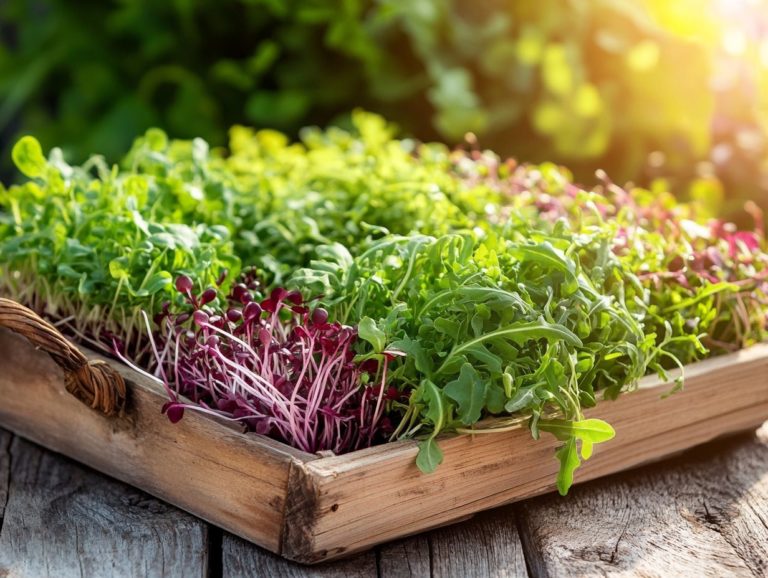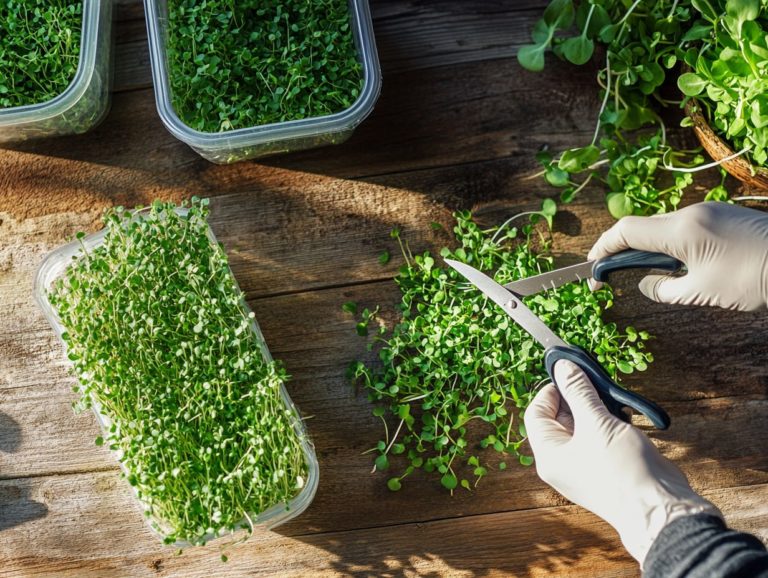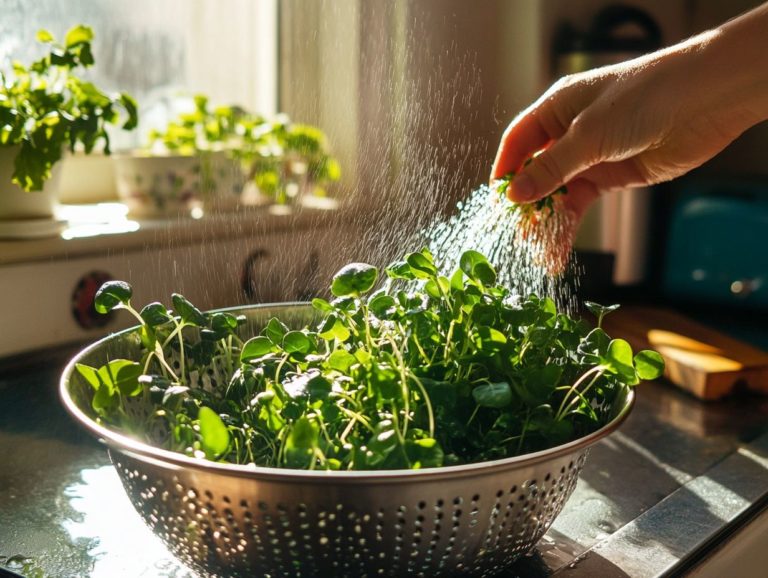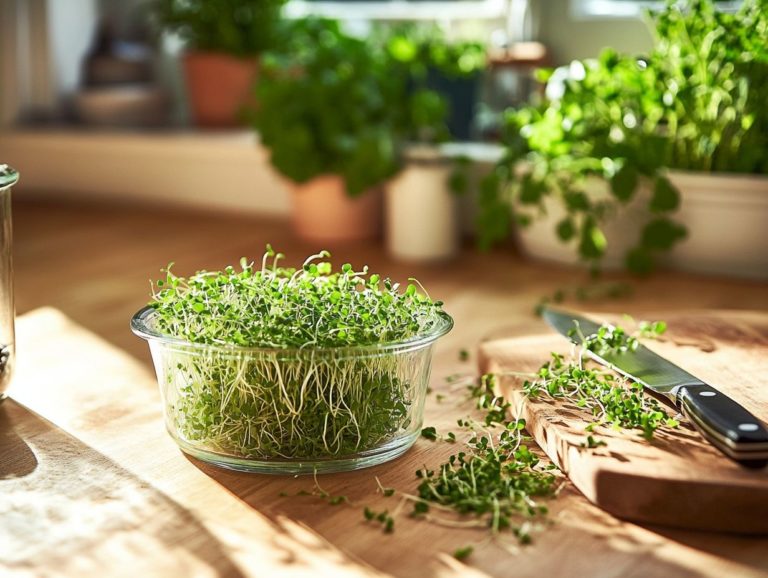5 Microgreen Harvesting Techniques to Try
Microgreens are a colorful and nutritious enhancement to your meals, offering a delightful burst of flavors and health benefits, ideal for a nutritious diet. Mastering the art of harvesting them correctly can elevate both their taste and nutritional value, making them a favorite in research for sustainable practices.
This guide covers five effective harvesting techniques, ranging from the convenient Cut and Come Again method to the comprehensive Whole Plant Harvesting approach, underscoring the importance of nutrition in food production. It also covers the ideal timing for harvesting, key factors to consider when selecting a method, including the importance of air circulation and water management, and valuable tips for storing these delicate greens.
Whether you’re a seasoned gardener or an inquisitive foodie, this information will empower you to maximize the potential of your microgreens.
Contents
- Key Takeaways:
- 1. Cut and Come Again Method
- 2. Stem Cutting Method
- 3. Whole Plant Harvesting Method
- 4. Root Cutting Method
- 5. Harvesting by Trimming Method
- When Is the Best Time to Harvest Microgreens?
- What Are the Different Types of Microgreens?
- What Factors Should Be Considered When Choosing a Harvesting Method?
- How Can Proper Harvesting Techniques Affect the Flavor and Nutritional Value of Microgreens?
- What Are Some Tips for Storing Harvested Microgreens?
- How Can One Incorporate Microgreens into Their Diet?
- Frequently Asked Questions
Key Takeaways:
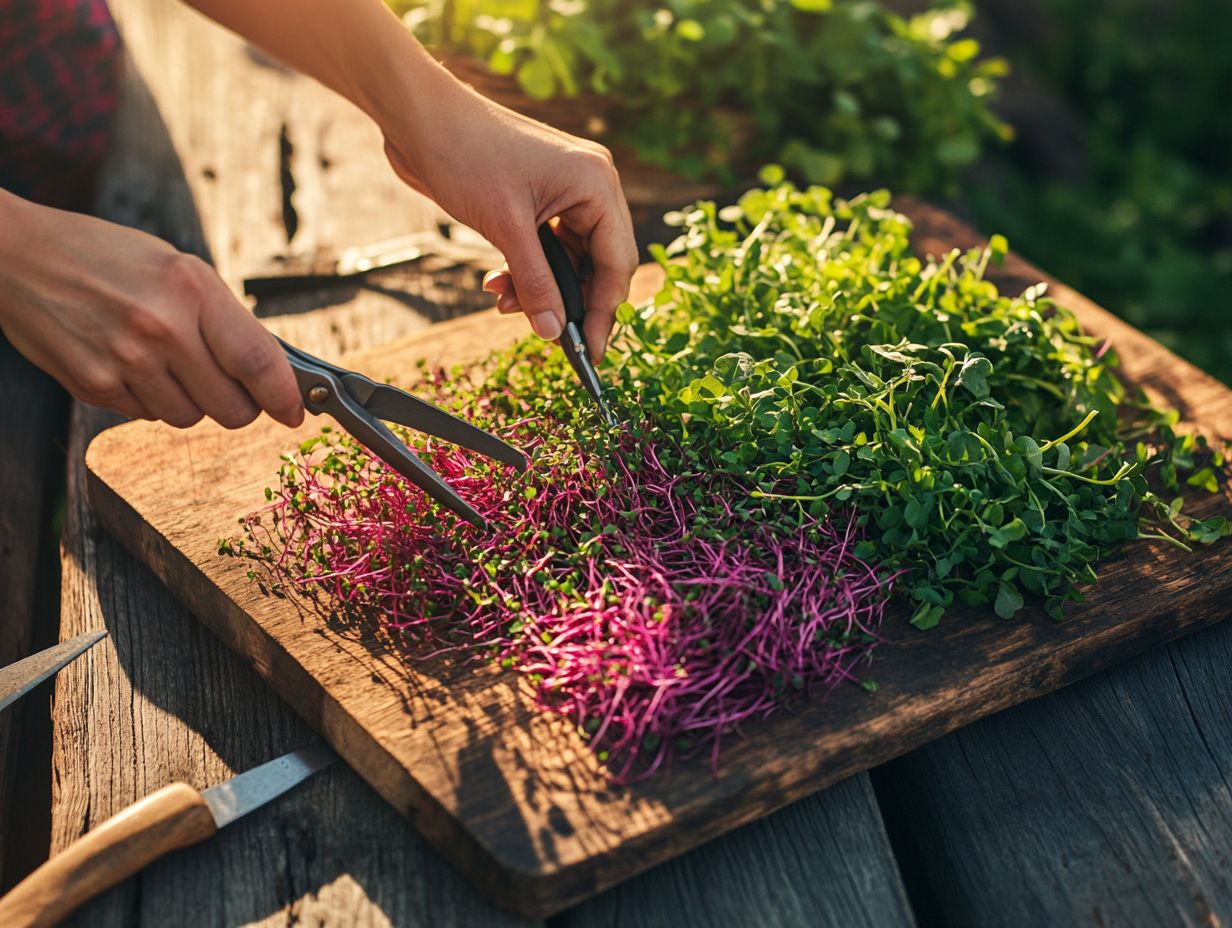
- The “Cut and Come Again” method allows for multiple harvests from one plant, making it a sustainable option.
- The stem cutting method is best for delicate microgreens like cilantro and basil.
- Consider plant type, growth stage, and final use when choosing a harvesting method for microgreens.
1. Cut and Come Again Method
The ‘Cut and Come Again’ method is your ticket to sustainable harvesting for microgreens, allowing you to enjoy repeated harvests of nutritious shoots while keeping your plants flourishing and packed with nutrients. By focusing on growth from the area where the roots are located, you ll ensure a steady flow of fresh microgreens, bursting with vitamins and minerals, ready to elevate the flavor of your culinary creations. This technique is a game-changer in both container and vegetable gardening.
Here s how it works: simply cut the microgreens just above the soil line, and watch as they spring back to life, producing new shoots from their existing root systems. As the food in the soil is effectively utilized, these microgreens can regenerate time and again throughout their growth cycle, helping you garden more sustainably.
If you’re keen on maximizing your yields, providing enough light and water while they grow back will significantly enhance growth rates. Varieties like arugula, kale, and radish are particularly suited for this method, responding quickly and vigorously to your harvesting efforts. For those interested in year-round cultivation, exploring techniques for growing microgreens year-round can be beneficial. Whether you opt for a sunny windowsill indoors or a spacious outdoor garden bed, adopting the ‘Cut and Come Again’ approach will guarantee a vibrant, continuous supply of nutritious greens for your table.
2. Stem Cutting Method
The Stem Cutting Method is an exceptional technique for harvesting microgreens, providing you with quick access to fresh produce while allowing the plants to regenerate beautifully in your kitchen garden.
This innovative approach not only minimizes waste but also maximizes your yield, making it a preferred choice for both novice and seasoned gardeners alike. To implement this method effectively, start by selecting a healthy plant, ensuring the stem is robust and disease-free. Next, grab your sterilized scissors and take cuttings just above the soil line; this encourages rapid regrowth.
Compared to traditional harvesting techniques, the stem cutting method retains more food within the plant, enhancing both flavor and quality. Whether you’re working with indoor setups or containers, maintaining enough light and water during regrowth is essential. For those interested in growing microgreen varieties from seed to harvest, don’t forget to wash the harvested greens thoroughly to remove any contaminants, and uphold proper hygiene throughout the process to ensure food safety.
Start your microgreen adventure today and enjoy fresh flavors right from your home!
3. Whole Plant Harvesting Method
The Whole Plant Harvesting Method involves uprooting the entire microgreen. This choice maximizes the nutrient composition and health benefits of your vegetable gardening.
This approach captures the full spectrum of nutrients that microgreens offer. It also enhances the flavor profile, elevating the taste of various dishes. For those looking to implement this technique with finesse, timing is essential. The ideal moment to harvest is just before the microgreens reach full maturity, ensuring you enjoy peak freshness and flavor. This typically occurs when the first true leaves emerge, usually within 10 to 14 days of growth. Exploring 5 unique microgreen varieties for exotic flavors can also enhance your culinary experience.
By combining the whole plant method with planting with compatible crops or rotating your crops, you can significantly improve soil health and yield while indulging in the culinary delights of nutrient-rich produce.
4. Root Cutting Method
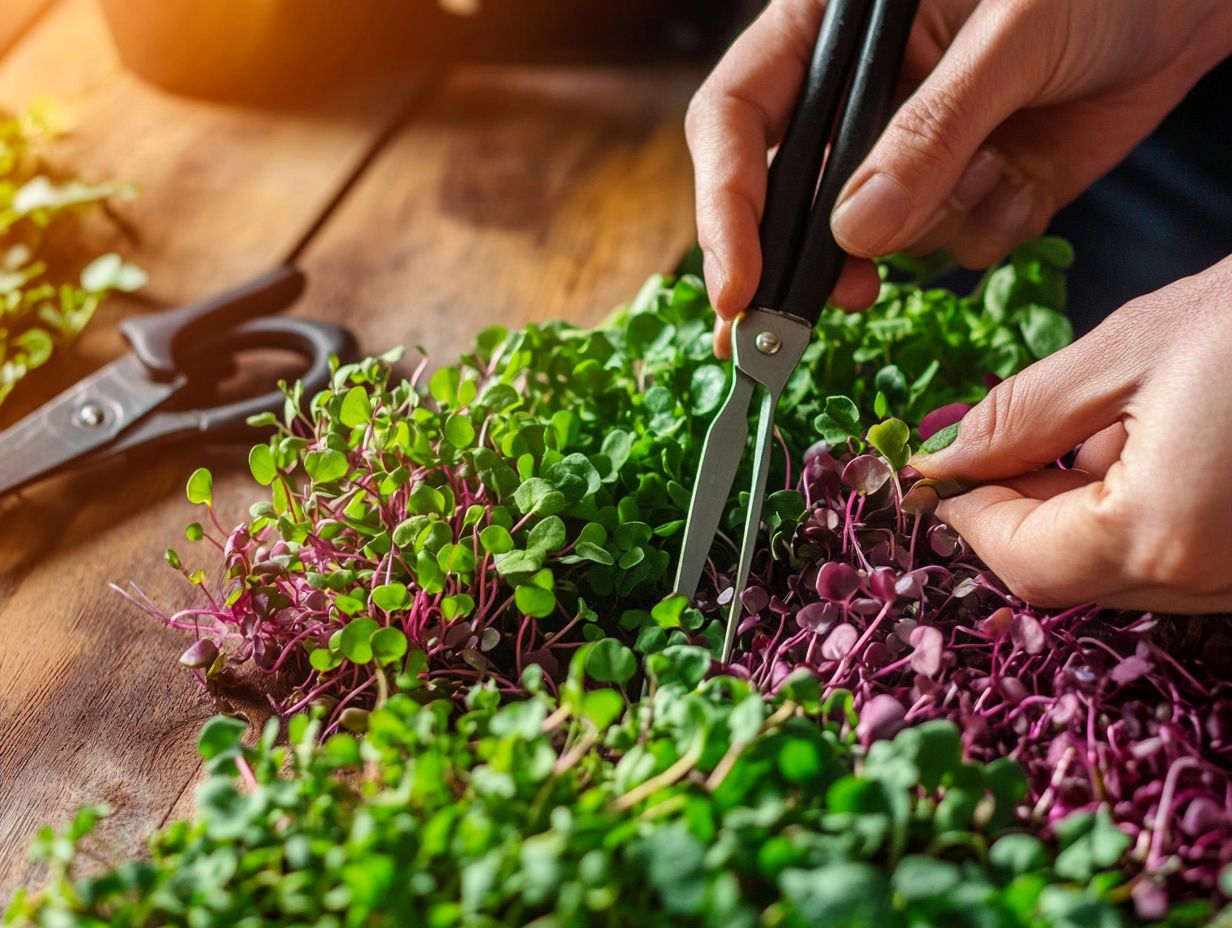
The Root Cutting Method is a specialized harvesting technique that allows you to cut microgreens at the root zone. This encourages regrowth while prioritizing soil health in your container gardening setup.
This innovative approach allows you to reap multiple harvests from the same planting and nurtures the growing environment. By making precise cuts, you can stimulate root systems, promoting quicker regrowth and minimizing the need for replanting, which is vital for efficient gardening. Exploring 5 microgreen varieties you can grow year-round can further enhance your gardening success.
This technique is a game-changer for smaller-scale operations, such as urban gardens, as well as larger agricultural setups. It boosts both yield and efficiency.
The method also supports soil structure and microbiome health, ensuring that your growing medium remains fertile. This practice proves invaluable across various gardening setups, from home pots to vertical farms, making it a versatile choice for eco-conscious growers like you.
5. Harvesting by Trimming Method
Harvesting by the Trimming Method is a refined technique that allows you to selectively trim microgreens. This enhances air circulation and prevents overcrowding in your growth boxes, which is essential for maintaining plant health.
This approach ensures your plants receive the light and space they need. It also boosts their overall health and growth. By avoiding the stress of uprooting, the remaining microgreens can continue to thrive, giving you potential for additional harvests. For inspiration, explore 5 microgreen varieties with unique textures to enhance your gardening experience.
To master trimming, use sharp, sterile scissors and make cuts at a slight angle to encourage further growth. This ensures food safety throughout the process. Strive for a balance between maximizing yield and maintaining quality. Be ready to adjust your techniques for different growth environments whether in an indoor setup or an outdoor garden. For more on enhancing your methods, consider exploring innovative methods for hydroponic microgreens. This way, you can optimize the flavor and texture of your final produce.
When Is the Best Time to Harvest Microgreens?
Determining the optimal time for harvesting microgreens is crucial to maximizing their nutritional value and flavor while promoting ideal plant growth. This consideration is essential for any passionate gardener.
To master this process, closely observe key indicators such as leaf size, color, and texture. For many varieties, the sweet spot occurs when the leaves reach about one to three inches in height, displaying a vibrant green hue that signals healthy growth.
The leaves should feel tender yet crisp, which often corresponds to peak flavors. Timing is everything; certain microgreens, like radish and mustard, can be ready in as little as 7 days. Others, such as basil, require a more patient approach, taking about 14 days. To ensure you get the best results, check out this guide on how to maximize yields from microgreens.
By understanding these variances, you enhance your culinary experience and ensure that your microgreens provide the maximum nutrients to support your dietary needs. Don’t wait! Start observing your microgreens today to enjoy the best flavor and nutrition!
What Are the Different Types of Microgreens?
Microgreens offer an impressive array of varieties, from broccoli and radish to carrot, basil, and sunflower. Each variety brings its own distinctive flavors, vitamins, and culinary applications while providing excellent health benefits.
Take broccoli microgreens, for example. They have a mild, slightly peppery taste and are loaded with vitamins A, C, and K. This makes them an exceptional choice for enhancing salads and sandwiches.
Radish microgreens, with their sharp flavor, can add a delightful kick to any meal. They often grace tacos or soups as a vibrant garnish.
Carrot microgreens introduce a hint of sweetness, making them perfect for smoothies or as an elegant topping for seafood. Meanwhile, basil microgreens provide a concentrated burst of aromatic flavor, ideal for elevating pasta dishes or enriching your pesto recipes.
Don t overlook sunflower microgreens; their nutty flavor is excellent for adding texture to grain bowls.
To successfully grow these varieties, ensure they receive adequate sunlight and moisture. Remember that basil prefers slightly warmer conditions, while radish microgreens thrive in cooler environments.
What Factors Should Be Considered When Choosing a Harvesting Method?
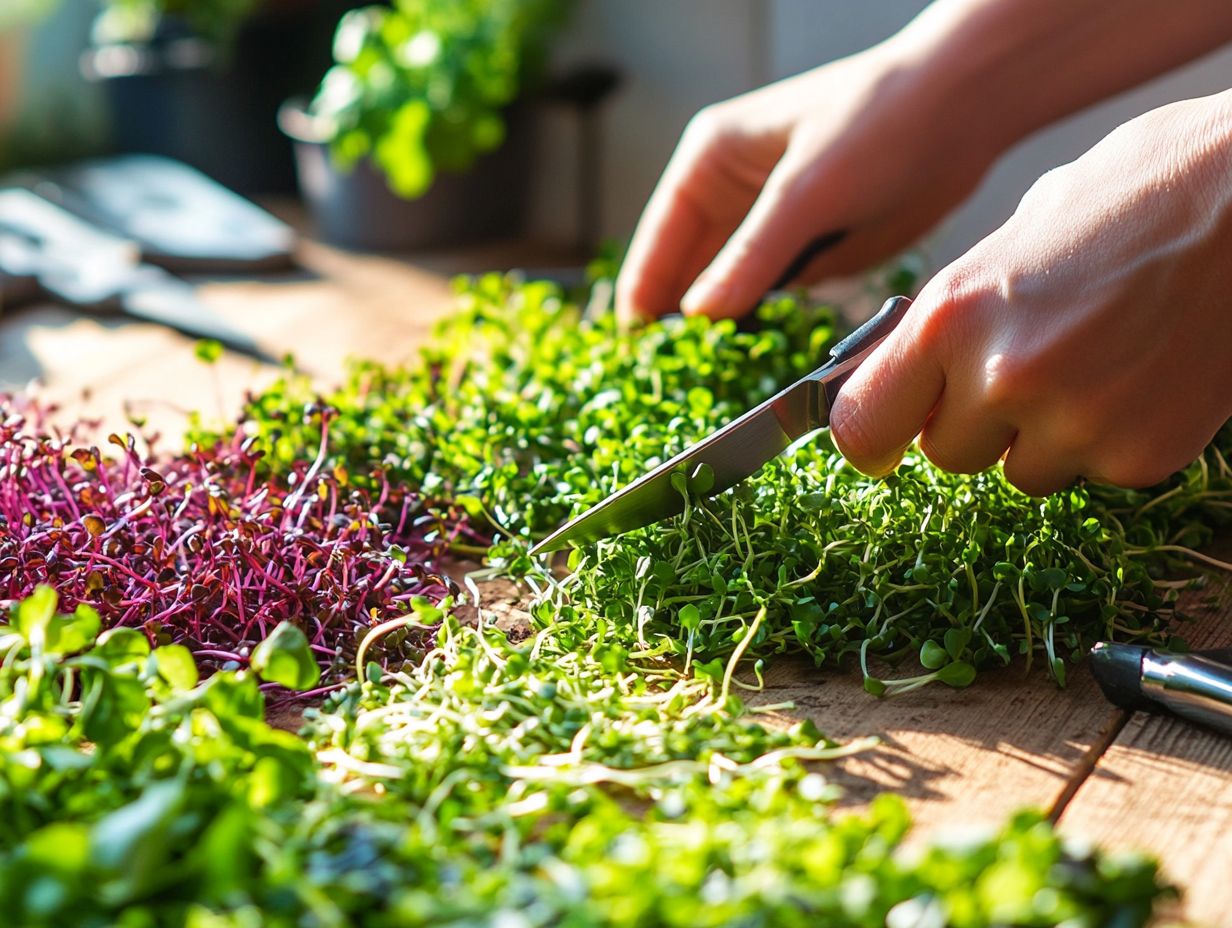
When choosing a harvesting method for your microgreens, it s essential to weigh factors like plant health, food safety, and your overall gardening experience. This consideration ensures that the process is both successful and enjoyable.
The type of microgreens you’re growing significantly influences the most effective harvesting technique. For example, delicate varieties like basil or pea shoots require gentle handling, while sturdier greens can endure more robust methods. To ensure success, you might also consider 5 tips for successful microgreen germination.
Environmental conditions like light, humidity, and temperature play a pivotal role in growth rates and the ideal harvesting time. Your gardening goals, whether you aim to maximize yield or simply enjoy gardening, should guide your choice of method.
To achieve optimal results, feel free to experiment with different techniques like container gardening. You might also consider incorporating 5 microgreen varieties for a healthy diet to enhance your gardening experience. Keep in mind the unique requirements of each crop and adjust your approach to what is most effective in your specific growing environment.
How Can Proper Harvesting Techniques Affect the Flavor and Nutritional Value of Microgreens?
Proper harvesting techniques can dramatically boost the flavor profiles and nutritional value of microgreens. This is essential for successful food production, whether at home or in commercial kitchens, especially in the context of space exploration.
For instance, cutting microgreens at just the right height and timing ensures these delicate plants maintain their vibrant flavors and vital nutrients. If you harvest too late, those prized greens might turn bitter, impacting their marketability and culinary potential.
Harvesting in the early morning, when moisture levels are high, can enhance their crispness and flavor. Gentle washing and proper drying are also crucial for preserving their nutritional integrity; rough handling can lead to nutrient loss and a decline in flavor.
Being mindful of these factors can truly elevate the quality of your final product and enhance your overall gardening experience.
What Are Some Tips for Storing Harvested Microgreens?
Storing harvested microgreens properly is crucial for preserving their freshness and nutritional value. This involves specific tips and techniques to ensure food safety and quality, especially in a home gardening context.
For the freshest microgreens, store them in a cool, dark place with temperatures between 32 and 41 degrees Fahrenheit and humidity levels around 90%. Utilizing airtight containers or sealed bags can significantly extend their shelf life by reducing exposure to air and moisture.
Incorporating composting methods not only helps with waste management but also enriches the soil for future growth, promoting sustainable practices. By employing these techniques, you maintain the quality of your microgreens while championing environmental responsibility, fostering a more holistic approach to food production.
How Can One Incorporate Microgreens into Their Diet?
Incorporating microgreens into your diet is a delightful way to elevate your meals with their vibrant flavors and impressive nutrients that are good for your health. They provide a nutritious boost to salads and sandwiches.
These tiny powerhouses are brimming with vitamins and minerals. They also add a burst of color and a unique taste to any culinary creation. For example, peppery arugula microgreens can transform a simple brunch dish when sprinkled atop poached eggs. Delicate basil greens can brighten up your favorite pasta or pizza. To learn more about using these greens, check out this guide on how to harvest popular microgreen varieties.
If you’re focusing on vegetarian or vegan diets, consider options like sunflower and pea shoots, which offer an excellent source of protein. Explore local farmers’ markets or specialty grocery stores to discover different varieties of these greens. This ensures you have fresh and organic choices that cater to your dietary needs.
Frequently Asked Questions
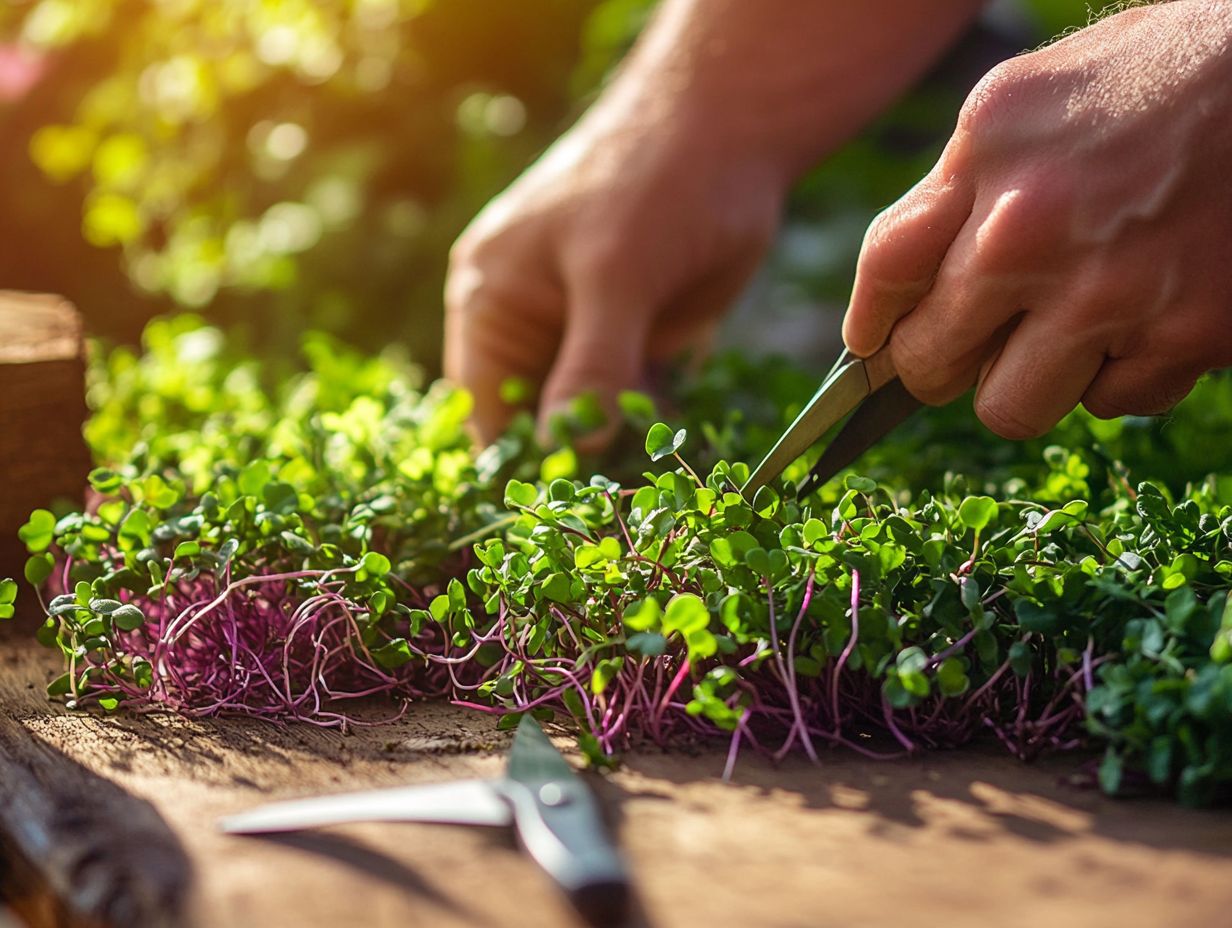
What are microgreens?
Curious about microgreens? Microgreens are young vegetable greens harvested at an early stage, typically after the first set of true leaves have formed. They are packed with nutrients and known to have a more intense flavor than their mature counterparts.
What are some benefits of growing microgreens?
Microgreens are easy to grow, take up minimal space, and can be grown year-round. They also provide a great source of vitamins, minerals, and antioxidants. Plus, they add a pop of color and flavor to any dish!
What are the best microgreens to harvest?
Some popular microgreens to try include broccoli, kale, radish, sunflower, and pea shoots. You can also experiment with different types of seeds to find the ones you like best.
What tools do I need for microgreen harvesting?
You will need clean scissors or a sharp knife, a clean cutting board or tray, and a container or bag to store the harvested microgreens. It’s also helpful to have a spray bottle filled with water for misting the greens.
What is the cut and come again method?
The cut and come again method involves cutting the microgreens just above the soil level, leaving the roots intact. This allows for multiple harvests from the same batch of microgreens, as they will continue to regrow. Only cut what you need and mist the remaining greens to keep them fresh.
What is the best time to harvest microgreens?
Microgreens can be harvested after the first set of true leaves forms, which typically takes 7-14 days depending on the type of microgreen. It’s best to harvest in the morning when the plants are hydrated and at their freshest.

